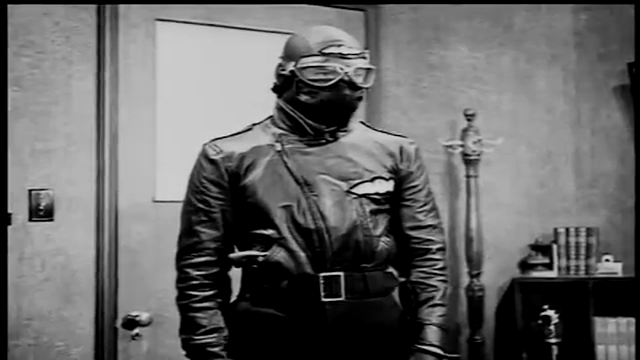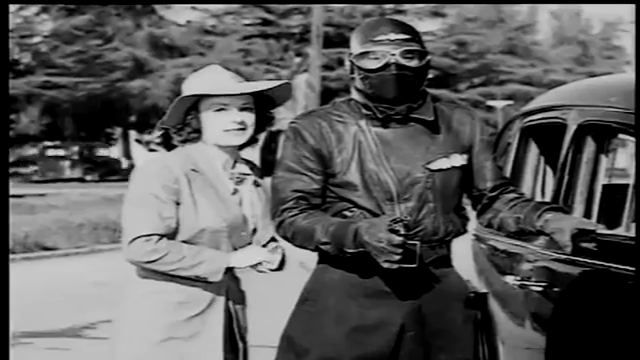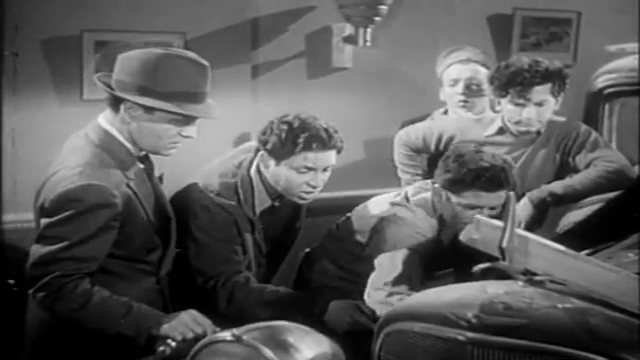-
#436 – Don Winslow of the Navy (1942)
Don Winslow of the Navy (1942)
Film review #436
Directors: Lewis D. Collins, Ray Taylor
SYNOPSIS: Commander Don Winslow of the U.S. Navy is assigned to stop a foreign spy ring that is intent on sabotaging the construction of a new naval base on an island in the Pacific Ocean. Winslow and his friends battle against the head of the spy ring, known only as “The Scorpion” and seek to foil his evil schemes across land, sea and air…
THOUGHTS/ANALYSIS: Don Winslow of the Navy is a 1942 film serial comprised of twelve chapters, and is based on the U.S. navy approved comic strip character of the same name. The story concerns Commander Winslow being assigned to stop a spy ring from sabotaging the construction of a new naval base in the Pacific Ocean. There’s not really anything special to say about the plot; it is a fairly standard setup that is found in nearly every wartime serial. While it is to be expected that these serials served as propaganda at the time for the war effort, Don Winslow was a character that was sanctioned and approved by the U.S. navy, so while this means that the uniforms and representation of the navy are fairly accurate, it probably means that there was a lot of oversight regarding what he should and shouldn’t do. I think this is probably the reason why he rarely gets into fistfights or other messy situations (although he does more so than in the sequel, where he never gets rough with anyone). Whereas the pre-wartime serials had plenty of lead characters that would don masks to conduct vigilante missions against the enemy, pre and post-war serials typically reserved such costumes and roles for the villains, while making leads that were victorious American soldiers.
The characters are about what you’d expect from a serial, with Winslow being the face of the navy in the serial, and being expectedly heroic and patriotic. His fellow navy officer “Red” serves as his friend and backup in the action scenes, and Mercedes Colby fills the single female role. The villains are also pretty standard, with a bunch of henchmen being led by a man who is only known as “The Scorpion,” who as usual is a white man in make-up to “look” Japanese. We only ever see him, however, on a screen in the spy’s secret base, and there is no final showdown with him (he is however, confronted in the sequel). One very distracting thing about The Scorpion is that with the close-ups of his face on the screen, you can clearly tell the actor is reading his lines as his eyes move left to right, which is quite distracting.
There’s plenty of stock footage used of navy vessels and submarines that makes the action a bit more exciting, which again is probably owed to the fact that the serial had the involvement of the U.S. navy (although I’m led to believe that the submarine that shows up in the stock footage is a British submarine). The models used for the airplanes and such, are far less convincing. The cliffhangers usually end up with Winslow getting caught in an explosion or a collapsing building, and usually walking away with nothing more than a limp. Again, fairly standard resolution to the chapter cliffhangers, and obviously they’re not going to show a navy officer getting seriously hurt if they’re being portrayed as strong invincible heroes of the war. Overall, Don Winslow of the Navy is what you would expect from a wartime serial. It’s not particularly interesting and neither does it offer anything new or original. The use of stock footage of ships and navy vessels gives it a larger sense of scale, but it’s a product of wartime propaganda that serves almost exclusively that purpose, and not worth seeking out.
-
#422 – Captain Midnight (1942)
Captain Midnight (1942)
Film review #422
Director: James W. Horne
SYNOPSIS: Professor Edwards has invented a new type of radar that will surely help the U.S. government in the war effort. However, a foreign power has employed criminal mastermind Ivan Shark to steal the device for their own use. Ace pilot Captain Allbright uses his secret identity of Captain Midnight to try to stop Shark and his men before the device falls into their hands, and to stop Shark’s bombing of American cities using his own aircraft…
THOUGHTS/ANALYSIS: Captain Midnight is a 1942 movie serial based on the radio plays of the same name. The plot is fairly straightforward and very familiar if you’ve ever seen a movie serial from this era: Ace pilot Captain Allbright uses his masked alter-ego Captain Midnight to stop a criminal from stealing a new weapon and selling it to an enemy government. It’s the same plot used through many wartime serials that would have had contemporary relevance. Unfortunately, there isn’t much content to separate it from the rest of similar serials, as there are plenty that use masked alter-ego’s, and also lots that centre around the use of planes. While using the characters from the popular radio play would have brought in extra viewers, there isn’t much uniqueness that viewers will get from the serial. The villain’s plots of stealing a new invention and bombing American cities are a bit interchangeable, and the serial moves back and forth without any real continuation or progression of the plot, resulting in very little development over the course of the fifteen chapters. Like every other serial, each chapter ends in a cliffhanger in which Captain Midnight faces certain doom only for it to be quickly resolved at the beginning of the next chapter. While these resolutions are usually anti-climactic, the serials produced by Columbia Pictures often have the least creative solutions, with Captain Midnight mostly just escaping car crashes or explosions by just walking from them a little dazed. In one such cliffhanger, he just walks away from a plane crash and jumps into a fistfight, which is quite ludicrous even by the serial’s standards.
Captain Allbright/Midnight is the typical serial hero: the square-jawed all-American hero who gets into plenty of fights and daredevil escapes. There doesn’t seem to be much point in his alter-ego: everyone seemingly knows who he is, and it wouldn’t matter if he was exposed or not. His “Secret Squadron” who aid him in his heroic deeds don’t really have a part to play, and what little we see of them shows they only fill very typical roles of sidekicks. Major Steele, Midnight’s government contact, is the authority figure who gives the orders and who Midnight plans with to catch the villains. The main villain himself, Ivan Shark, has a distinguishing trait in that he is a master of disguise, and subsequently disguises himself as a number of the serial’s characters over the course of the fifteen chapters; including Captain Midnight himself. His disguises also come with dubbed voice-overs of the characters he is playing, which is very obvious. It’s a trait that was used by the protagonist in The Spider serials, and definitely used to better effect there. Shark’s daughter Fury (that is her name apparently) has a role as second-in-command, but doesn’t really play much of a part. At the start of the serial, she seems reluctant to follow some of her Father’s schemes, leading me to believe she may be a character that swaps sides and questions her loyalties, but that is perhaps too complex for this serial, as this trait is soon forgotten and quickly becomes just another flat villain giving orders.
The main problem with Captain Midnight is that it’s story goes nowhere. There’s no build-up, and the focus keeps shifting so it feels like nothing of consequence is happening, which means it is going to be difficult to keep viewer’s attention over the course of fifteen chapters (or four and a half hours). Some of the stunts are decent, but nothing too outstanding, and there’s not enough plane-based scenes that you might expect from the titular character. The villain’s motivations are confused and all over the place, which further confounds any attempt to advance the plot. Although it doesn’t stray from the typical serial formula, there’s definitely better examples of the format you can watch.
-
#416 – Junior G-Men of the Air (1942)
Junior G-Men of the Air (1942)
Film review #416
Directors: Lewis D. Collins, Ray Taylor
SYNOPSIS: “Ace” Holden and his friends hang out at his Father’s airstrip, hoping to enter the local air race while Ace’s younger brother Eddie is inventing a new plane engine. Ace and his friends witness a bank robbery, and when they refuse to cooperate with the local G-man, they try and find the robbers, not realising that they belong to the “Order of the Black Dragonfly” a foreign organisation that is attempting to sabotage American industry and pave the way for an invasion. Ace and his friends join up with the junior G-men in order to combat this threat to themselves and their country…
THOUGHTS/ANALYSIS: Junior G-men of the Air is a 1942 film serial composed of twelve chapters, and the third to feature the young group of actors The Dead End Kids and The Little Tough Guys, although none of the serials are connected or have the same characters. This time, the kids are help to salvage junk at the airfield owned by the Father of one of the boys, Ace. While out collecting junk in their truck, they witness a robbery on a bank by a gang who steal their truck to make their getaway. Ace manages to get a strange broach of one of the men, but when the local G-man, Don Ames asks for the kids cooperation, they refuse due to their distrust of law enforcement. It turns out the robbers belong to a group known as the “Order of the Black Dragonfly,” a fifth column gang of saboteurs looking to destabilise American society to pave the way for a foreign invasion. As the serial progresses and Ace’s younger brother Eddie is kidnapped, the kids join up with the junior G-men, led by Jerry Markham, to find the gang and put a stop to them. The film’s plot is quite similar to Junior G-men, the first serial featuring the group of young actors, but while that one had a setting on land, and Sea Raiders focused on the sea, this one is centred around the air and aeroplanes, although there’s not too much action in the air. At least each of them have something unique about them. Other than that there’s not too much special about the story, but as with its predecessors, having the leads be these young, unruly boys rather than the typical all-american hero offers something a little different to the vast majority of serials.
The characters of the young actors are quite similar to the ones they played in the previous serials, but I suppose they are hired to play those specific roles. The leader of the gang, Ace, is the usual agitator and instigator, although he appears a bit more tidy than the previous serials for reasons I’ll get into below. At least his name isn’t Billy this time as well. Huntz Hall as “Bolts” plays his usual idiots sidekick routine without any real surprises, and “Stick” and “Greaseball” play mostly supporting roles, but they do have more lines and action than in the previous serials. While the kids are still troublemakers and somewhat hostile to any person of the law, they are less abrasive and unlikable than they were in previous serials, which again I’ll get into below. Other characters including “Double Face” Gordon add some variety to the line-up, while Don Ames as the G-man provide the more typical straight-laced law enforcement hero. Once again there’s no real female characters aside from a minor secretarial role, as it’s clear the serial is aimed at young boys of a more rebellious nature. The villains are classed as saboteurs, destroying America from within, and are obviously meant to be representing Japan. As is usual for these serials, The Japanese characters are all played by white Americans in make-up to “look” Japanese, which is not a good look to say the least, and a practice which sadly persevered for years in the film industry. Other than that, there’s nothing too remarkable about them.
Let’s get into the main aim of this serial: it is a giant propaganda piece for young Americans to serve their country in any way possible. By the time of the serials release, the U.S. had officially entered the Second World war after the attack on Pearl Harbour, and Anti-Japanese sentiment as overwhelming. A lot of these serial have secret Japanese societies of saboteurs fuelling this sentiment, as well as convincing the public to suspicious of everything around them. That the rough antics of the lead kids and their hostility to law enforcement is toned down in this serial compared to the previous ones is probably due to delivering this message that everyone must help their country in any way they can, in fact there’s multiple scenes that explicitly deliver this line. The final chapter of the serial is one big battle where the army storms the farm where the villains have set up a base, making it look like a battlefield and displaying the glorious victory of American troops. At the end everyone remarks about how vigilant they must be against enemies from within who threaten to destroy the American way of life, when they get new that Pearl Harbour has been attacked and they must now get ready for war and remain more vigilant than before. A lot of wartime serials push this messaging, but this serial is definitely more blatant about it than others I’ve seen. Maybe because it’s aimed at the younger rebellious generation that might be more reluctant to get behind their country. nevertheless, this makes for a much more interesting finale than you get in most serials, with the large scale battle making for an interesting payoff, even if it feels like mostly stock-footage not involving most of the main cast.
Overall, Junior G-men of the Air is a decent enough serial with plenty of action to keep younger viewers entertained. The overwhelming sense of wartime propaganda that fills some of the scenes is a bit much (although there’s definitely worse), and the frankly racist depiction of Japanese people as sneaky and devious is badly outdated, which was sadly not uncommon in film for a significant period of time. It doesn’t offer much that the previous two serials featuring the young actors doesn’t, but like the other two, at least does something a little different to most serials.
-
#376 – The Mad Monster (1942)
The Mad Monster (1942)
Film review #376
Director: Sam Newfield
SYNOPSIS: Dr. Cameron, a scientist, has been experimenting with genetic modification, a practice which has left him the subject of ridicule and forces him from his university job. Out in the country, he experiments on his hired help Pedro to turn him into a werewolf, but when Pedro starts killing people in his werewolf form, Dr. Cameron finds it increasingly difficult to keep his experiments a secret…
THOUGHTS/ANALYSIS: The Mad Monster is a 1942 horror/sci-fi film. The film centres around Dr. Cameron, a scientist whose experiments in genetic engineering have left him ridiculed and cast out of the scientific community. He moves out into the country with his daughter Lenora to carry on his experiments, using his hired help Pedro as a test subject. Cameron successfully develops a serum that can turn Pedro into a werewolf-like creature, which ends up escaping and killing a little girl. Pedro is unable to remember the time when he is transformed, so Cameron uses this to his advantage to take revenge on those that ridiculed his research. The story is quite straightforward, and there’s no real surprises. The plot is all explained at the beginning, and it is up to the characters to unravel the mystery themselves. there’s nothing really special about the film, it’s another simple story of science going too far that has been done many times before (and after).
The film attempts to create a horror atmosphere through some creative use of lighting and dark, minimal sets. Although all the violence happens off-screen (this is the 1940′s after all), so it is difficult to get much of an idea of how vicious this werewolf creature is. The cast of characters is pretty bland, but well defined, and everyone contributes to the story in some way. The acting and delivery of lines is sometimes a bit flat, but credit to the actor playing Pedro, who gives an expressive performance. One of the biggest drawbacks of the film is that it often feels boring, with scenes that drag on too long consisting of dull conversations that go nowhere. You become very aware of the beginning and ending of scenes as they mostly end on flat notes without much fanfare, leaving you to wonder what the point of it was.
As mentioned, the production values of the film are rather low, owing to the general state of the world at the time and having more pressing issues to address. Nevertheless, there are a few positives, such as Pedro’s “werewolf” make-up or costume being quite well put together. Sometimes Dr. Cameron delivers a good speech under an atmospheric light, but other than that there’s really not much else that stands out. The Mad Monster is an entirely forgettable film with a typical message of science going too far, and a blandness in terms of its looks and its dialogue leave little to recommend it.





































